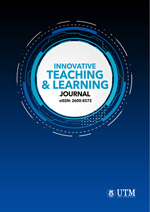The Opportunities and challenges in virtual reality for virtual laboratories
DOI:
https://doi.org/10.11113/itlj.v6.91Keywords:
Virtual reality, Instructional design, Design model, Sense of presence, Realism, Virtual reality technologies, Head-mounted displayAbstract
The use of extended reality (XR) technologies, namely Augmented Reality (AR), Virtual Reality (VR) and Mixed Reality(MR) in education, has attracted much attention in recent years. Since the middle of the 20th century, virtual reality (VR) has been a part of our lives. Today, technology has made virtual reality accessible to everyone. In the last ten years, virtual reality equipment has become suitable for individual use and has started to be used by large numbers of people. Virtual reality can now be used for educational purposes, including education virtual laboratories. The studies were carried out to reveal the advantages of virtual reality compared to traditional media tools, as well as the conclusion that a successful instructional design process plays a major role in the success of technology in education. In line with what has been mentioned, we review in this paper the historical development of virtual reality technologies, followed by the use of Extended reality technology in the field of education, including virtual laboratories. This paper is to argue and present evidence from extensive research that VR can be a valuable tool in engineering, such as virtual laboratories. As a result of the review we conducted, we were able to conclude that VR has a positive pedagogical and cognitive impact on engineering education, thus increasing students' understanding of the subjects, their grades and performance, and overall satisfaction with their education. Furthermore, VR, as a replacement for physical laboratories, can reduce university liability, infrastructure, and costs. It was also discovered that VR applications for education currently lack the integration of learning theories and objectives in engineering education. In this research, we aim to provide recommendations and guidelines for researchers who want to work in the field of virtual reality and to offer suggestions for virtual laboratories.

















